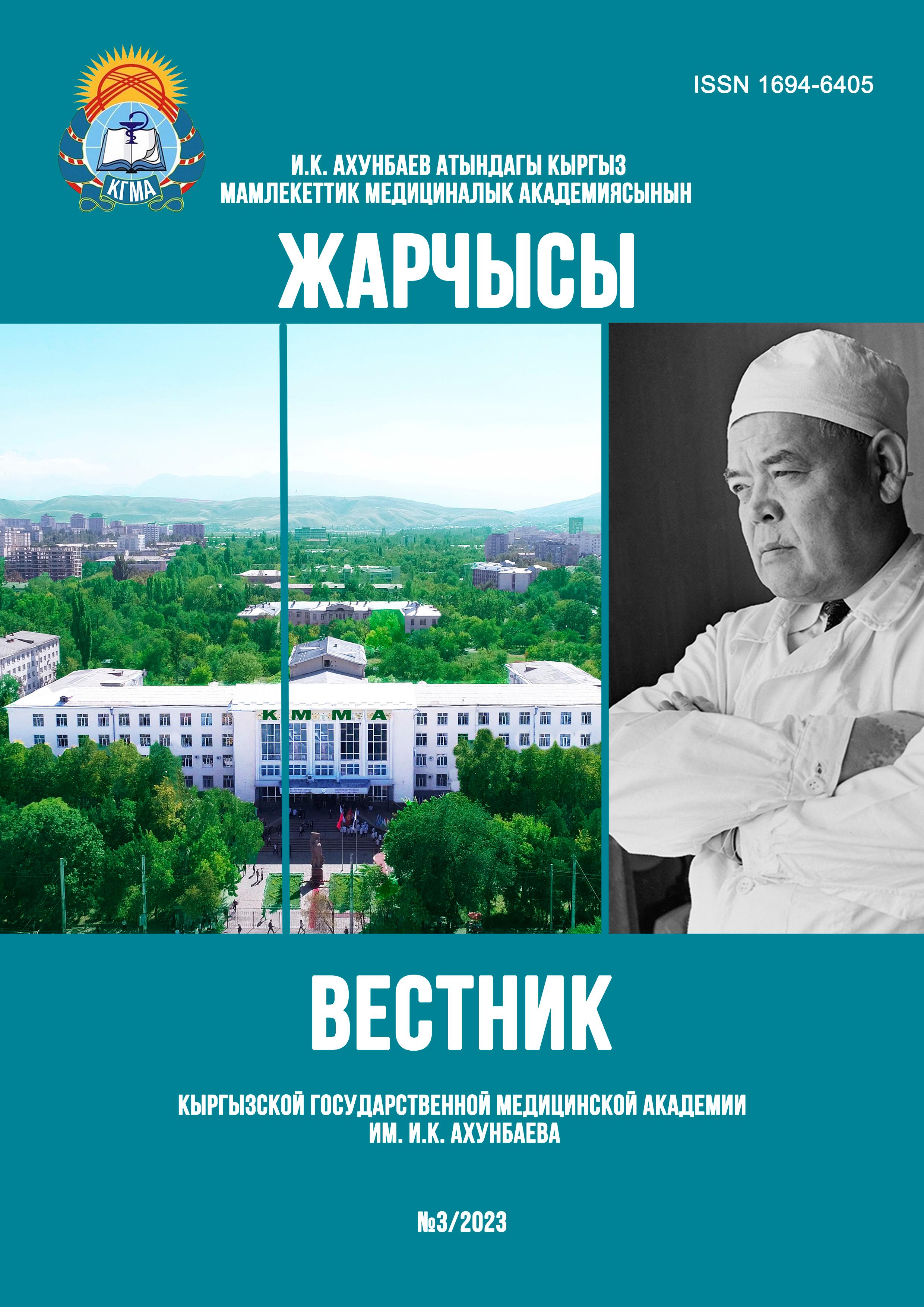МЕДИКАМЕНТОЗНОЕ ЛЕЧЕНИЕ ОСТРЫХ И ХРОНИЧЕСКИХ ЗАБОЛЕВАНИЙ ПОЧЕК ПРИ ОБСТРУКТИВНЫХ УРОПАТИЯХ (ОБЗОР ЛИТЕРАТУРЫ)
DOI:
https://doi.org/10.54890/1694-6405_2023_3_168Аннотация
Обструктивные уропатии являются распространенной причиной острого и хронического заболевания почек. Декомпрессия мочевыводящих путей является единственным наиболее полезным аспектом лечения; почечная недостаточность часто обратима, и долгосрочный почечный прогноз, как правило, благоприятный. Последующая медицинская помощь является важным, но недооцененным дополнением к хирургическому лечению. Острое купирование обструкции часто осложняется нарушением баланса натрия и калия и постобструктивным диурезом. Принципы долгосрочного ведения такие же, как и при других формах хронической болезни почек. Обструкция может происходить на любом уровне, от почечных канальцев (цилиндры, кристаллы) до наружного отверстия уретры. Обструкция гораздо более распространена среди мужчин (обычно вследствие развития доброкачественной гиперплазии простаты), но врожденные и приобретенные стриктуры уретры и стенозы отверстия мочеиспускательного канала встречаются у представителей обоих полов. У женщин обструкция уретры может развиваться на фоне первичной или метастатической опухоли или в результате образования стриктуры после лучевой терапии, хирургии или урологических инвазивных манипуляций (обычно – повторных дилатаций).
Цель исследования: оптимизация методов лечения обструктивных уропатий в различных возрастных группах и оздоровление населения. Материал и методы. В основу работы положены результаты обследования и лечения пациентов детей и взрослых с врожденными обструктивными заболеваниями мочевых путей, находившихся на лечении в НГ МЗ КР Центр урологии и отделения урологии НЦОМиД. Выводы: Использование лекарственной терапии целесообразно только после хирургической коррекции обструктивных уропатий в основу которых входят операции по нормализации пассажа мочи.
Ключевые слова:
обструктивные уропатии, нефропатии, декомпрессия, электролитные нарушения, почечная недостатоность, пиелонефрит, хроническая болезнь почек.Библиографические ссылки
1. Кабаев Б.А., Усупбаев А.Ч., Садырбеков Н.Ж., Кожомкулова К.А., Периоперационная антибиотикопроффилактика в хирургической урологии (Учебно- методическое пособие). Бишкек: КГМА; 2021. 41 с.
2. Tseng TY, Stoller ML. Obstructive uropathy. 2009; 25(3):437–443. https://doi.org/10.1016/j.cger.2009.06.003
3. Mourmourisa PI, Chirasb T, Papatsorisa AG. Obstructive Uropathy: From Etiopathology to Therapy. World J Nephrol Urol. 2014;3(1):1-6. https://doi.org/10.14740/wjnu154w
4. Steddon S, Chesser A, Cunningham J, Ashman N. Oxford Handbook of Nephrology and Hypertension. 2nd Edition. Oxford University Press; 2014. 726 p.
5. Marshall JR, Haber J, Josephson EB. An evidence-based approach to emergency department management of acute urinary retention. Emerg Med Pract. 2014; 16(1):1-24.
6. Курбаналиев Р.М., Усупбаев А.Ч., Еркович А.А., Колесниченко И.В. Мониторинг врожденных пороков развития мочевыделительной системы. Вестник КГМА им. И.К.Ахунбаева. 2017;3:143–148.
7. Boettcher S, Brandt AS, Roth S, Mathers MJ, Lazica DA. Urinary retention: benefit of gradual bladder decompression - myth or truth? A randomized controlled trial. 2013;91:140–144. https://doi.org/10.1159/000350943
8. Chávez-Iñiguez JS, Navarro-Gallardo GJ, Medina-González R, Alcantar-Vallin L, García-García G. Acute Kidney Injury Caused by Obstructive Nephropathy. 2020: 8846622. https://doi.org/10.1155/2020/8846622
9. Murnaghan GF. The physiology of hydronephrosis. Postgrad Med J.1958;34(389):143–148.
10. Cohen EP, Sobrero M, Roxe DM, Levin ML. Reversibility of long-standing urinary tract obstruction requiring long-term dialysis. Arch Intern Med. 1992;152(1):177-179.
11. Hiatt MJ, Ivanova L, Trnka P, Solomon M, Matsell DG. Urinary tract obstruction in the mouse: the kinetics of distal nephron injury. Lab Invest. 2013;93:1012–1023. https://doi.org/10.1038/labinvest.2013.90
12. Кабаев Б.А., Кубанычбек у Б., Рыскулбеков Н.Р., Кырбашев К.Д., Усенбаев Б.О., Султанов Б.М. Особенности послеоперационных инфекционных осложнений в урологии. Вестник КГМА им. И.К. Ахунбаева. 2021;5-6:35–42.
13. Harrison S, Lasri A, Jabbour Y, Slaoui A, Djamal J, Karmouni T et al. Post-Obstructive Diuresis: Physiopathology, Diagnosis and Management after Urological Treatment of Obstructive Renal Failure. Open Journal of Urology. 2018;8(9):267–274.
14. Muldowney FP, Duffy GJ, Kelly DG, Duff FA, Harrington C, Freaney R. Sodium diuresis after relief of obstructive uropathy. 1966; 274:1294–1298. https://doi.org/10.1056/NEJM196606092742304
15. Moore FD. Common patterns of water and electrolyte change in injury, surgery and disease. N Engl J Med. 1958;258(7): 325–33. https://doi.org/10.1056/NEJM195802132580705.
16. Foster MC, Upsdell SM, O'Reilly PH. Urological myths. BMJ. 1990;301(6766):1421–1423. https://doi.org/10.1136/bmj.301.6766.1421
17. Nyman MA, Schwenk NM, Silverstein MD. Management of urinary retention: rapid versus gradual decompression and risk of complications. Mayo Clin Proc. 1997;72:951–956. https://doi.org/10.1016/S0025-6196(11)63368-5
18. Yap E, Salifu M, Ahmad T, Sanusi A, Joseph A, Mallappallil M. Atypical Causes of Urinary Tract Obstruction. 2019: 4903693. https://doi.org/10.1155/2019/4903693
19. Halbgewachs C, Domes T. Postobstructive diuresis: pay close attention to urinary retention. Can Fam Physician. 2015;61:137–142.
20. Roth JD, Lesier JD, Casey JT, Szymanski KM, Whittam BM, Misseri R. Incidence of pathologic postobstructive diuresis after resolution of ureteropelvic junction obstruction with a normal contralateral kidney. 2018;14:557.e1–557.e6. https://doi.org/10.1016/j.jpurol.2018.07.012
21. Yarger WE, Aynedjian HS, Bank N. A micropuncture study of postobstructive diuresis in the rat. J Clin Invest. 1972;51(3):625-37. https://doi.org/10.1172/JCI106852







